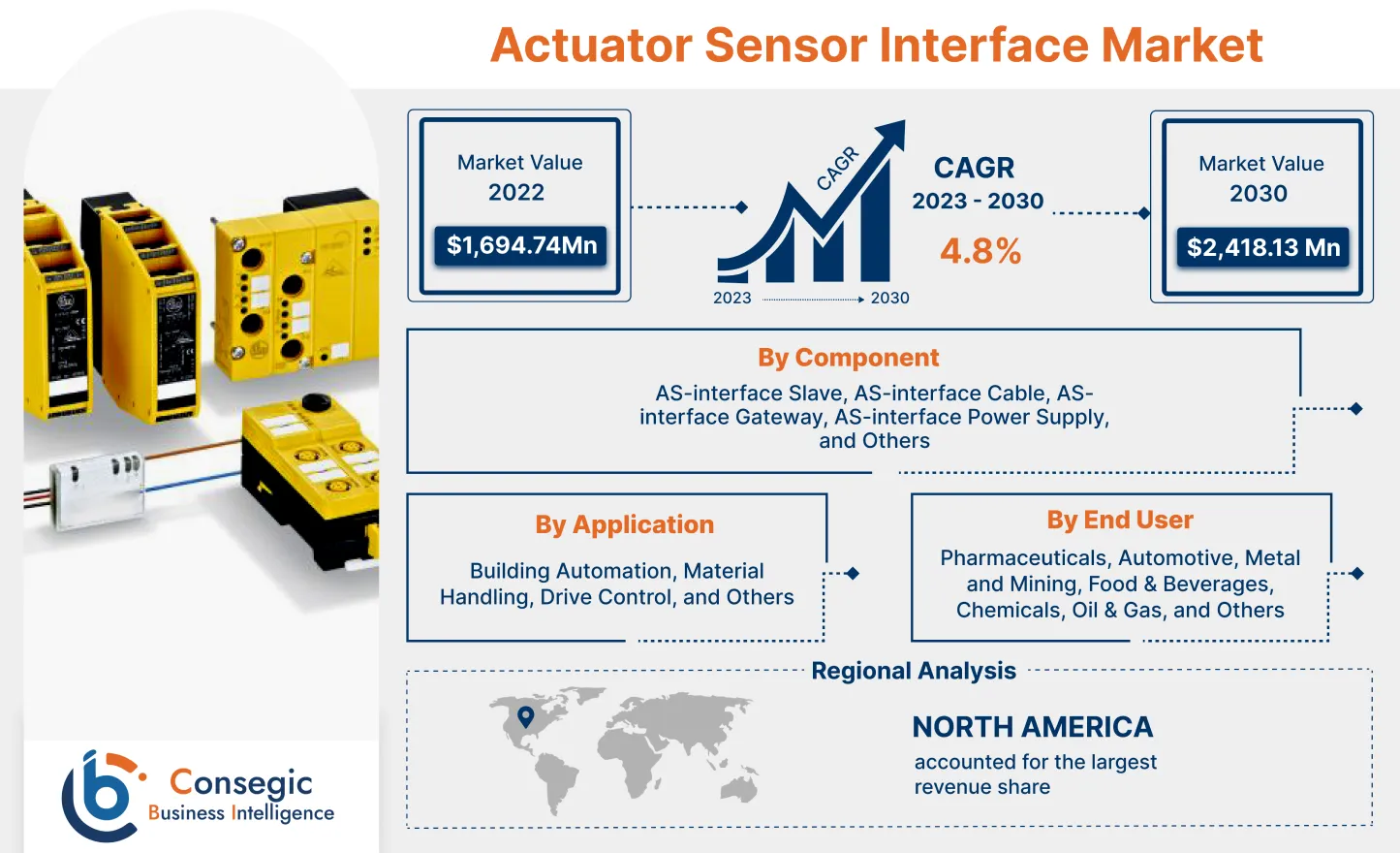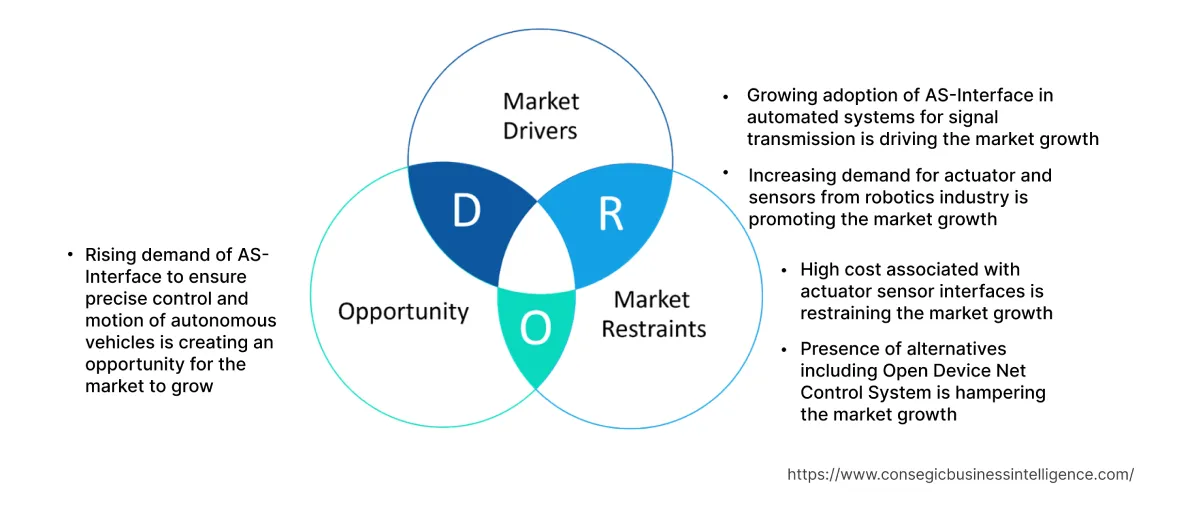Actuator Sensor Interface Market Introduction :
Actuator Sensor Interface Market size is estimated to reach over USD 2,418.13 Million by 2030 from a value of USD 1,694.74 Million in 2022, growing at a CAGR of 4.8% from 2023 to 2030.
Actuator Sensor Interface Market Definition & Overview :
The actuator sensor interface (AS-Interface) is defined as the connection between an actuator and a sensor in a control system. In a control system, sensors are responsible for monitoring physical activity in response to environmental changes and transmit the information to the control system, which further signals the actuator to perform physical actions. Based on the analysis, this system enables the communication between the actuator and the sensor to work effectively within the control system. The interface involves electrical connections, signal conditioning, and data transmission protocols that facilitate the exchange of information between the actuator and the sensor.
Actuator Sensor Interface Market Insights :
Actuator Sensor Interface Market Dynamics - (DRO) :
Key Drivers :
Growing adoption of AS-Interface in automated systems for signal transmission is driving the market growth
Actuator sensor interfaces are essential components of automated systems, enabling precise control and monitoring to achieve higher efficiency and productivity in operations. In addition, these sensor interfaces facilitate real-time control and monitoring of industrial processes by enabling seamless communication between actuators and sensors, providing accurate feedback and data on system performance. The level of control and monitoring is critical in automation to enable quick error detection leading to improved speed of the system. For instance, in January 2021, Sapcon Instruments Pvt Ltd. launched vibrating fork-level sensor series with this interface to enable efficient signal transmission in an automated system. As per the analysis, the interface allows reliable real-time digital communication, thus contributing significantly in driving the growth of the actuator sensor interface market trend.
Increasing demand for actuator and sensors from robotics industry is promoting the market growth
Robotics rely heavily on actuators for controlling and coordinating the movements of robotic arms, robotic manipulators, and drone propellers, and the sensors are widely employed for perception, environment sensing, and navigation. These interfaces play a vital role by connecting sensors including LiDAR and GPS with robots, enabling the robots to gather real-time data about the surroundings and prevent errors. Consequently, based on the analysis, the ability of these sensor interfaces to ensure precise control of actuators, enabling smooth and accurate motion of robots is accelerating the growth of the market. For instance, in November 2022, the University of Manchester made an announcement with the launch of an advanced multi-disciplinary center to study the developments in the field of robotics and AI. The aim of the development is to design a control system using actuators and sensors and autonomous machinery, hence contributing significantly in bolstering the actuator sensor interface market growth and trends.
Key Restraints :
High cost associated with actuator sensor interfaces is restraining the market
The major factor restraining the growth of this market is the high cost of production of the sensors. The components involved in the manufacturing of the interface include a Programmable Logic Controller (PLC) and Digital Combat Simulator (DCS) which are expensive to produce. The high cost limits the adoption of the actuator sensors by small organizations, thus impeding the development of the market.
Presence of alternatives including Open Device Net Control System is hampering the market
The ability of an open device net control system offering improved productivity and uptime in comparison to this interface is hindering the expansion of the market. Additionally, an open device net control system allows faster processing of information and enhanced diagnostic capability for troubleshooting, further restraining the development of the actuator sensor interface market. Consequently, the aforementioned factors including improved productivity and diagnostic capability of open device net control system are compelling the users to seek alternatives, which in turn, is impeding the rise of the global actuator sensor interface market.
Future Opportunities :
Rising demand of AS-Interface to ensure precise control and motion of autonomous vehicles is creating opportunities for the market to grow
Autonomous vehicles rely on actuator systems to control various components, including steering, braking, acceleration, and suspension. These interfaces are responsible for enabling precise control and motion in autonomous vehicles, ensuring accurate responses to navigate commands and sensor inputs. Additionally, as per the analysis autonomous vehicles require a wide array of sensors namely cameras, LiDAR, radar, and ultrasonic sensors, to perceive the environment. Consequently, the association of sensors with the AI interfaces allows autonomous vehicles to collect and analyze data from multiple sources resulting in improved perception accuracy and safety. Thus, the utilization of these interface for control and motion of autonomous vehicles are creating lucrative actuator sensor interface market opportunities and trends in the upcoming years
Actuator Sensor Interface Market Report Insights :
| Report Attributes | Report Details |
| Study Timeline | 2017-2030 |
| Market Size in 2030 | USD 2,418.13 Million |
| CAGR (2023-2030) | 4.8% |
| Based on the Component | AS-interface Slave, AS-interface Cable, AS-interface Gateway, AS-interface Power Supply, and Others |
| Based on the Application | Building Automation, Material Handling, Drive Control, and Others |
| Based on the End-User | Pharmaceuticals, Automotive, Metal and Mining, Food & Beverages, Chemicals, Oil & Gas, and Others |
| Based on the Region | North America, Europe, Asia-Pacific, Latin America, and Middle East & Africa |
| Key Players | ABB Group, Baumer Electric AG, Biehl+Wiedemann GmbHand, Emerson Electric Co., IFM Electronic GmbH, Pepperl+Fuchs GmbH, Phoenix Contact GmbH & Co., Schneider Electric S E., Siemens AG, Valmet Corporation |
Actuator Sensor Interface Market Segmental Analysis :
Based on the Component :
The component segment is classified into AS-interface Slave, AS-interface Cable, AS-interface Gateway, AS-interface Power Supply, and others. The AS-interface gateway accounted for the largest market share in 2022 owing to the increasing applications in home energy products. Additionally, the AS-interface gateway optimizes energy usage and aids in reducing costs and carbon dioxide emissions. Moreover, the increasing adoption of AS-interface gateways in several interoperable devices, homes, and buildings to provide efficient and sustainable solutions is also driving the market. For instance, in March 2022, Schneider Electric launched Matter-certified AS-interface wiser gateway to provide effective communication in the Home Energy Management system (HEMS) network. The gateway optimizes energy usage resulting in reduced costs, thus contributing significantly in accelerating the development of the actuator sensor interface market.
AS-interface power supply is expected to register the fastest CAGR in the actuator sensor interface market during the forecast period. The expansion is endorsed by the ability of the AS-interface power supply to operate at an ambient range of temperature from -25 to +70°C. In addition, the AS-interface power supply offers high efficiency (approximately 94%) resulting in reduced power losses and longer field life. Furthermore, with the increasing adoption of automation in various industries including manufacturing and automotive the demand for AS-interface power supply is increasing to supply essential power for seamless operation. In conclusion, the aforementioned factors including improved efficiency and the ability to function at various temperature ranges are collectively responsible in fueling the market trend during the forecast period.
Based on the Application :
The application segment is classified into building automation, material handling, drive control, and others. Material handling accounted for the largest actuator sensor interface market share of 30.21% in 2022 as AS-interface offers improved conductivity and durability for the easy handling of materials in electronic devices and systems. Additionally, this sensor interface simplifies the wiring process, reduces installation time, and enables efficient communication between the conveyor components. Moreover, the advent of advanced technologies including elastomer technology to provide improved durability is also contributing in boosting the rise of the actuator sensor interface market. For instance, in June 2021, Zeon Corporation announced the production of sheet-based thermal materials using a sensor interface offering enhanced conductivity. Based on the analysis, the material is designed using elastomer technology to offer durability to electrical devices, hence contributing remarkably to promoting the development of the actuator sensor interface market.
The drive control system is anticipated to witness the fastest CAGR during the forecast period as AS-interface technology is extensively employed in drive control applications to facilitate communication and control between drives and the control system. The interface allows the integration of motor drives and associated sensors, namely encoders or limit switches, into the control system. Additionally, the actuator sensor interface provides a cost-effective communication interface for controlling motor speed, direction, and other parameters in a drive control system. Subsequently, based on the actuator sensor interface market analysis, the ability of these interfaces to enable an effective communication network in the drive control system is expected to drive the market trend in the upcoming years.
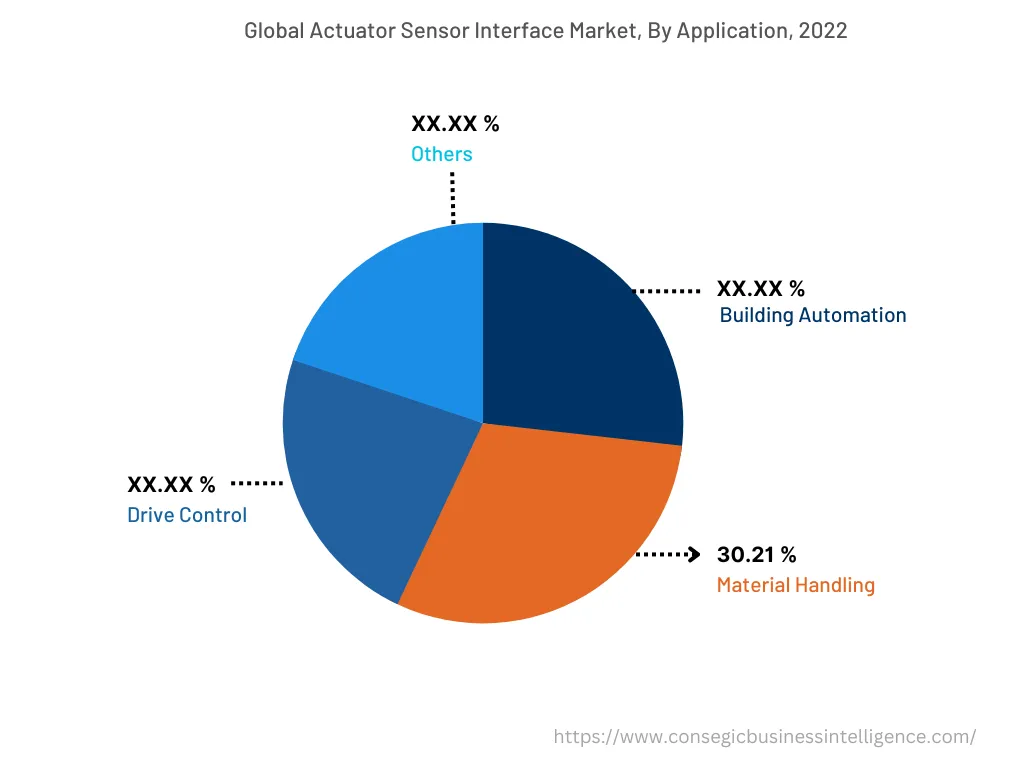
Based on the End-User :
The end-user segment is divided into pharmaceuticals, automotive, metal and mining, food & beverages, chemicals, oil & gas, and others. The automotive sector accounted for the largest market share in 2022 owing to the increasing utilization of this interface in motor control systems to enable communication between actuators and sensors involved in engine management, fuel injection, ignition control, and exhaust systems. Additionally, the interface facilitates precise control of sensors including throttle position sensors, oxygen sensors, and exhaust gas recirculation valves, ensuring optimal engine performance and emission control.
Furthermore, actuator and sensor control offer enhanced security, rich connectivity, and functional safety capabilities bolstering the trend of the global actuator sensor interface market. For instance, in December 2021, Renesas launched automotive actuator and sensor control MCUs to offer highly reliable solutions for systems ranging from zone control to actuators. The product is designed to function at high temperatures up to 150°C and is employed in motor control evaluation systems, driving the market trend.
Food and beverage sector is predicted to register the fastest CAGR during the forecast period in the actuator sensor interface market. The trend of the market is attributed to the increasing application of this interface in conveyor systems for material handling and transportation of food and beverage products. In addition, the interface facilitates real-time communication between the control system and the conveyor components, ensuring accurate tracking, sorting, and routing of products. Furthermore, the interface is also deployed in process control applications in the food and beverage sector to monitor and control parameters including temperature, pressure, flow, and level in various processing stages. Subsequently, the ability of this interface to ensure accurate measurement and control of such parameters to enhance product quality, consistency, and safety is expected to drive the market during the forecast period.
Based on the Region :
The regional segment includes North America, Europe, Asia Pacific, Middle East and Africa, and Latin America.
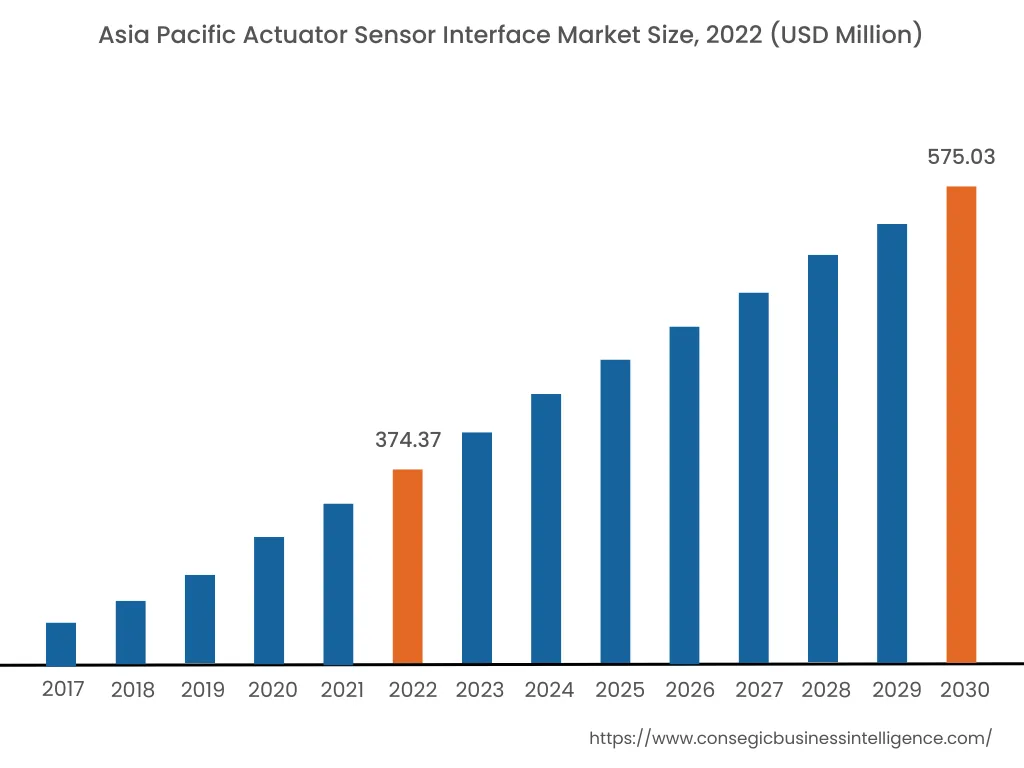
North America accounted for the largest revenue share in the year 2022 as the region has a robust and diverse manufacturing sector, ranging from automotive and electronics to food and beverages. The industrial sector requires efficient and reliable automation solutions that raise the demand for these interface to offer reliable solutions for effective network communication. In addition, North America has several research institutions and key manufacturers that have a strong focus on research and development, leading to the development of advanced actuator sensor interfaces. Consequently, the expanding manufacturing sector and the presence of key players are collectively contributing in increasing the actuator sensor interface market demand to improve automation in various end-use industries in the region.
Asia Pacific accounted for a revenue share of USD 374.37 Million in 2022 and is anticipated to register the fastest CAGR of 5.8% accounting to USD 575.03 Million in 2030 in the actuator sensor interface market. In addition, in the region, China accounted for the maximum revenue share of 25.8% in the year 2022. Asia Pacific is experiencing rapid industrialization across various sectors, including automotive, electronics, manufacturing, and food processing that increases the demand for these systems to enhance productivity, efficiency, and automation. Furthermore, Asia Pacific is witnessing the growing adoption of industrial automation particularly robotics that further increases the demand and trend for actuator sensor interfaces for precise control and monitoring, which in turn, promotes the expansion of the market in Asia Pacific countries. For instance, in December 2022, according to the Korea Association of Robot Industry, the revenue recorded in the robot sector in South Korea was approximately 9.56 trillion in 2021 showcasing an exponential rise of 4.1% in comparison to the previous year 2020.
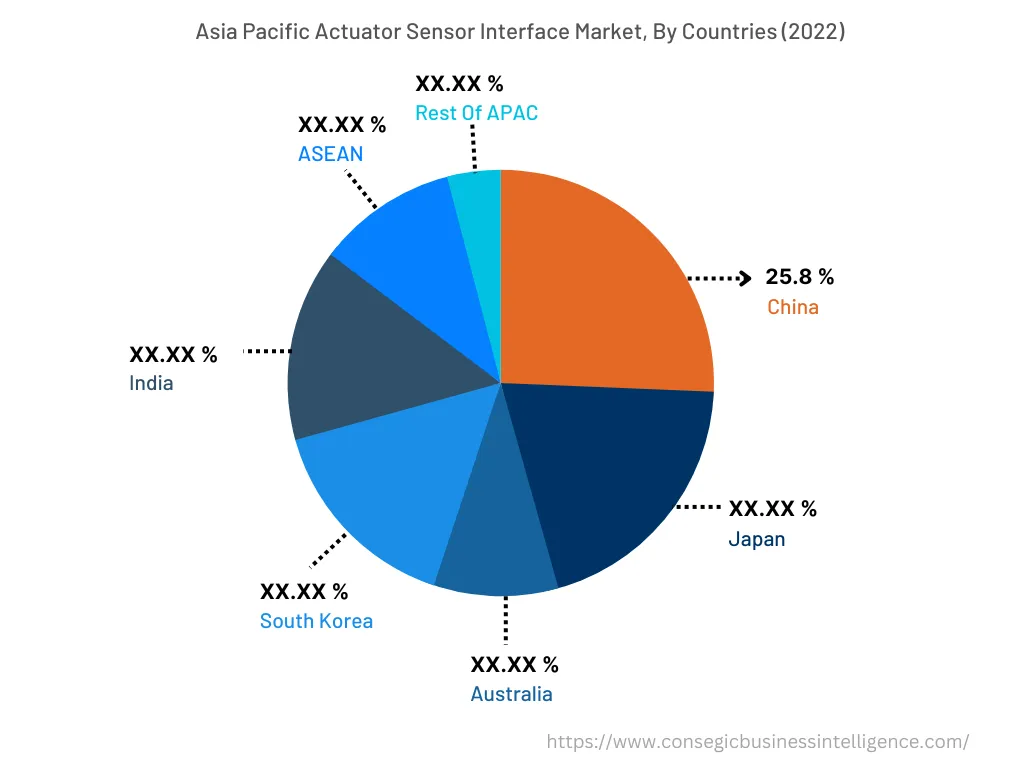
Top Key Players & Market Share Insights :
The landscape of the actuator sensor interface market is highly competitive and has been examined in the report, along with complete profiles of the key players operating in the industry. In addition, the surge in innovations, acquisitions, mergers, and partnerships has further accelerated the growth of the actuator sensor interface industry. Major players in the market include-
- ABB Group
- Biehl+Wiedemann GmbHand
- IFM Electronic GmbH
- Phoenix Contact GmbH & Co.
- Siemens AG
- Baumer Electric AG
- Emerson Electric Co.
- Pepperl+Fuchs GmbH
- Schneider Electric S E.
- Valmet Corporation
Recent Industry Developments :
- In June 2022, Emerson launched AVENTICSTM Series Servo Profile Advanced Electric Actuators with three screw technologies to provide improved durability and accuracy, speed, and heavy loads.
- In February 2022, ABB completed the installation and the remote appointing of the Slice II Profiler system, an advanced actuator at ITC Limited Tribeni mill with an in-built monitoring system in West Bengal for the slice lip weight control.
Key Questions Answered in the Report
What is the actuator sensor interface? +
The actuator sensor interface (AS-Interface) is defined as the connection between an actuator and a sensor in a control system. In a control system, actuators are responsible for producing physical output based on control signals, while sensors detect and measure physical variables and provide feedback to the control system.
What specific segmentation details are covered in the actuator sensor interface market report, and how is the dominating segment impacting the market growth? +
The report consists of segments including component, application, end-user, and region. Each segment has a key dominating sub-segment being driven by industry trends and market dynamics. For instance, the component segment has witnessed the actuator sensor interface gateway as the dominating segment in the year 2022, driven by the ability to optimize energy usage and aid in reducing costs and carbon dioxide emissions.
What specific segmentation details are covered in the actuator sensor interface market report, and how is the fastest segment anticipated to impact the market growth? +
The report consists of segments including component, application, end-user, and region. Each segment is projected to have the fastest-growing sub-segment driven by industry trends and drivers. For instance, in the application, the drive control sub-segment is anticipated to witness the fastest CAGR growth during the forecast period. The growth is attributed to the increasing use of AS-interface technology in drive control applications to facilitate communication and control between drives and the control system.
Which region is anticipated to witness the highest CAGR during the forecast period, 2023-2030? +
Asia Pacific is anticipated to witness the fastest CAGR during the forecast period owing to the expanding industrial automation sector that raises the demand for advanced technologies including actuator sensor interfaces.
